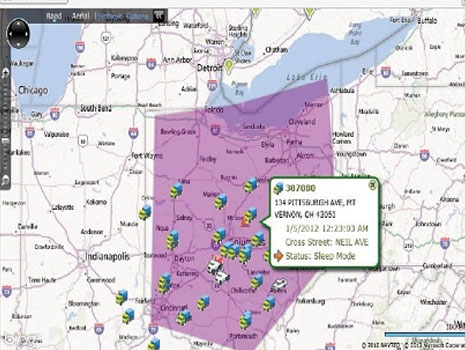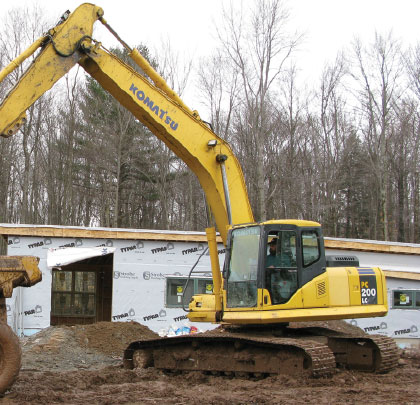For a contractor, ensuring that a project is completed on time and on budget is not an easy task. However, with the proper equipment and tools in place, the project can become simpler to manage. One cost-cutting feature that contractors can implement is vehicle and equipment telematics. This communication technology allows contractors to monitor the location, status, and movements of their vehicles. Beyond location information, GPS tracking solutions display a wealth of data that help reduce fuel costs, cut down on idling, improve safety, and strengthen loss prevention efforts.
GPS TRACKING
For companies with a fleet of vehicles, issues like idling, uninformed customer service representatives and poorly optimized routes can cost businesses big, both in the short and long-term. The longer these issues go unresolved, the less likely a business is able to gain traction in the marketplace.
There are plenty of ways that GPS fleet management systems can benefit a company, but the biggest motivation is to monitor the location of vehicles and drivers. This is why GPS tracking offers more than location management. Contractors can utilize location tracking to create more efficient routes, maintain driver oversight and keep vehicles secure.
In fact, nearly one-third of fleet companies that invest in fleet management systems do so in order to stay informed about their employees, vehicles and equipment, according to a recent survey completed by C.J. Driscoll & Associates.
Contractors can specifically gain the benefits of GPS tracking through:
- Knowledge of where vehicles are at all times
- Efficient routing for faster delivery and response time
- Higher fuel economy
- Lower vehicle maintenance
- Loss prevention of vehicles and assets
ROUTING AND NAVIGATION
It’s impossible to choose the best routes for company drivers without location knowledge of each vehicle in a fleet. The absence of this information leads to lost time, excessive mileage, increased fuel costs, and unnecessary vehicle maintenance.
GPS tracking systems streamline vehicle routing with ease. Dispatchers get their drivers to jobs faster by assigning the most efficient routes via a GPS navigation device. Contractors enjoy the boost from routing and navigation due to driver productivity and enhanced customer service. Contractors can gain the benefits of routing through:
- Fast responses to job locations
- Eliminating outside route mileage
- Reducing fuel use
- Improving customer service
- Increasing fleet productivity
LOSS PREVENTION
With assets spread throughout a large area, it can be burdensome to keep track of every vehicle and piece of equipment that can be lost or stolen. However, implementing a proper GPS tracking system assists contractors with location detection, so they are aware of vehicle and asset location every hour of the day.
Utilizing the GPS geographic zone settings in a telematics system will provide notifications if a vehicle or any equipment travels outside of a designated zone. Should a theft occur, fleet managers can call a stolen vehicle tracking hotline, allowing for the immediate tracking of a vehicle or asset.
FUEL
Investing in fuel efficiency solutions is one of the smartest decisions a contractor can make. It provides a way to shrink idling engine time, cut out harsh braking, eliminate out of route miles, and avoid traffic dilemmas.
Reducing idle time saves on fuel costs, but the benefits for contractors don’t end there. An idling vehicle can consume one to 1.5 gallons of gas per hour. According to the American Trucking Association, 1 hour of idling per day over the course of a year results in the equivalent of 64,000 miles in engine wear when adding up all the contributing factors. Contractors benefit from reducing fuel use through decreased engine maintenance costs and longer engine life.
GEO-FENCING
Geo-fencing is a term used to describe an invisible perimeter around a landmark set by a user. Vehicle activity within a geo-fence can be configured, including notifications about vehicles leaving or entering a location. Geo-fencing empowers contractors with insight into unauthorized vehicle activity, such as after-hour use or visits to non-work-related areas during operating hours.
 By setting up custom landmarks for jobsites, depots, and maintenance facilities, managers can track vehicle and equipment activity, such as delays at a jobsite or authorized vehicle use.
By setting up custom landmarks for jobsites, depots, and maintenance facilities, managers can track vehicle and equipment activity, such as delays at a jobsite or authorized vehicle use.
Once a geo-fence is set around a landmark, users can monitor stationary time, ignition status and the hours that a vehicle spends at any given geographic point. Users can create a perimeter by selecting a radius for each landmark.
Contractors can also create and receive real-time notifications when vehicles enter or leave a landmark, which provides invaluable information when approving timecards and planning workloads for drivers.
Contractors benefit from using geo-fences by:
- Less unauthorized vehicle use
- Increased overall safety
- Reduced vehicle and equipment theft
- Real-time updates of vehicle activity
Every contracting company needs to find ways to increase efficiency and cut expenses. However, if a company is unable able to pinpoint problem areas, it makes that goal nearly impossible to attain.
Using a technology solution, such as a GPS tracking platform, helps businesses identify previously unnoticed issues while simultaneously providing a way to keep track of all of its assets in a much more efficient and cost-effective manner. ■
About the Author: Mike Jarvinen is vice president of marketing with Teletrac, Inc. For more information, call 800-TELETRAC, or visit www.teletrac.com
[divider]
Modern Contractor Solutions, April 2014
Did you enjoy this article?
Subscribe to the FREE Digital Edition of Modern Contractor Solutions magazine.



